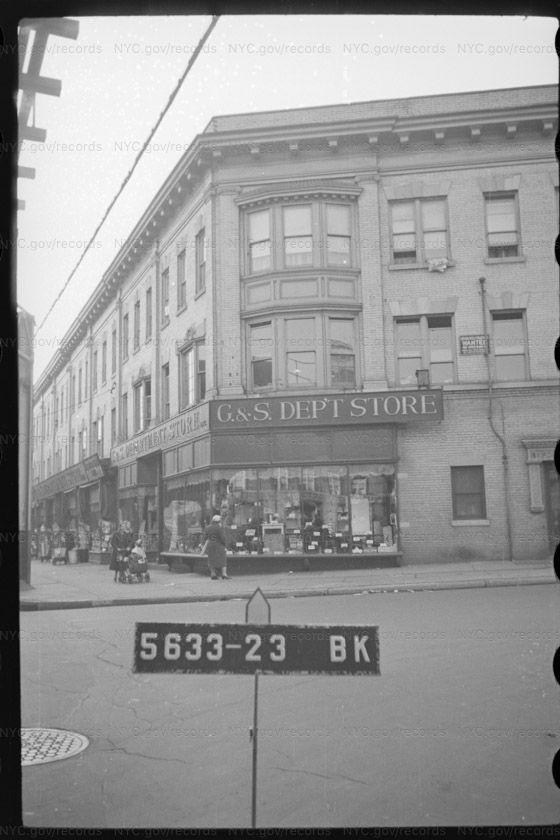In Boro Park, Brooklyn, in the 1960s, we knew this store as G. & S. Or, “the dry goods store.” Merriam-Webster has two definitions of dry goods :
1 : grocery items (such as tobacco, sugar, flour, and coffee) that do not contain liquidI think it’s no. 2 that fits G. & S.
2 : textiles, ready-to-wear clothing, and notions as distinguished especially from hardware and groceries
The earliest reference to the store that I can find at Brooklyn Newsstand is a listing in an ad for Congoleum dealers:
[The Brooklyn Daily Eagle, October 2, 1928.]
Two years later, there’s an ad with a handy location marker:
 [The Brooklyn Daily Eagle, May 7, 1930.]
[The Brooklyn Daily Eagle, May 7, 1930.]What I remember of this store (which spanned several storefronts): no shelves, just merchandise in cardboard boxes, with prices written on packages with a grease pencil or Magic Marker. (Let’s be real: it must have been a grease pencil.) I remember things like dish towels and white tee-shirts and household chemicals. Lysol, maybe. Maybe Eveready batteries? I don’t know — because I was a kid, not someone taking notes for a blog post.

 [G. & S. Department Store, 4806–14 New Utrecht Avenue, Brooklyn, c. 1939–1941. From the NYC Municipal Archives Collections. Click either image for a larger view. And notice the “Floor Covering Dept.” signage in the second photograph.]
[G. & S. Department Store, 4806–14 New Utrecht Avenue, Brooklyn, c. 1939–1941. From the NYC Municipal Archives Collections. Click either image for a larger view. And notice the “Floor Covering Dept.” signage in the second photograph.]My brother Brian says that G. & S. stood for “Gary and Son.” I think I remember our dad once imparting that bit of Brooklyn fact. (He was just the kind of guy who’d be willing to ask a store clerk.) At some point the store became G. & Sons. That name appears in this 1963 advertisement:
 [Kings Courier, June 15, 1963. Click for a larger view.]
[Kings Courier, June 15, 1963. Click for a larger view.]You can see a G. & Sons sign in this c. 1983–1988 tax photo. The storefront later housed a National Wholesale Liquidators outlet, followed by Albert & Sons. Google Maps shows that Albert was gone by 2017. A 2021 Google Maps photograph shows this office building still under construction, with an Amazing Savings store on the ground floor. Notice that the illustration is careful to obscure the presence of the El overhead.
Thanks, Brian.
Related posts
More photographs from the NYC Municipal Archives
[If you’d like to go down the Congoluem rabbit-hole: you’ve been warned.]


comments: 3
excellent invocation of a bygone era
Oddly enough over here in the UK in the food trade, "dry goods" does not necessarily mean "goods that are dry", as the concept is partly muddled by the pub distinction between "the dry trade" and "the wet trade" (the latter referring to alcohol), and partly muddled by whether VAT is added to the good or not. So for example milk would often be classed as a dry good, as although liquid it is not alcohol, and it is typically part of drinks which are served as part of the dry trade, ie meals.
A good example, perhaps, of how usage has departed from etymology or strict meaning :)
Very interesting. I just checked the OED, which has this: “A name (chiefly in North American usage) for the class of merchandise comprising textile fabrics and related things; articles of drapery, mercery, and haberdashery (as opposed to groceries).” And this note: “This entry has not yet been fully updated (first published 1897; most recently modified version published online June 2022).” The most recent citation is from 1968.
The meaning you describe must be one that the dictionary needs to catch up with.
Post a Comment